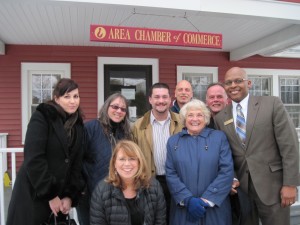Baiting a Red Hook

The village of Red Hook is the lesser known sister to Rhinebeck and somehow that just isn”™t right. The Lutheran congregation there is 295 years old, yet the road in front of its 100-year-old St. Paul”™s Church rumbles nonstop with 21st-century commercial activity ”“ you”™d think there would be more notice.
“We have Bard College, shopping, hiking, farmstands and a delightful place to live,” said Pat Holden, who has run the Red Hook Country Inn on South Broadway for six-plus years with husband, Nabil Ayoub and whose business career ”“ “This is our retirement,” she laughed ”“ was in municipal economic development. “But we need a stronger brand presence. Rhinebeck has a brand; Red Hook is the little sister. We need to be better branded.”
Which is not at all like saying Red Hook does not bring the complete package to the table via the goods and services of the 260 members of the Red Hook Area Chamber of Commerce. Holden is clear about that, seated in the fully restored, 170-year-old inn that was once home to the village doctor: “People will hurry to Rhinebeck without realizing Red Hook has so much to offer,” she said. “What we offer is very personal service. We who pour our own coffee, who ring up our own sales, really care ”“ that”™s the personality of the mom-and-pop shops that we have here. For us, it means we know our guests and we have high percentage of return guests.”
The town of Red Hook embraces the hamlets of Barrytown and Annandale-on-Hudson ”“ home to Bard College on Route 9G ”“ and the villages of Red Hook and Tivoli. There are also a number of smaller communities and named enclaves: Cokertown on Route 56 among them.

Red Hook Town Supervisor Sue Crane cited Bard as “an amazing resource” and described a relationship of comity and also one of historic synergy, perhaps both underreported: “Fourteen years ago, then-Justice Dick Griffiths told me the amount of money that flowed from Bard into the community annually was $22 million,” she said. “I have not heard another number, but $22 million 14 years ago tells you something. That”™s a big number. Bard is just a huge asset in our community.”
Seated in Rhinebeck Savings Bank on South Broadway with the supervisor and a half-dozen other chamber members, branch manager and chamber President Edward Pruitt noted Bard had, for the first time, joined the chamber in 2010 and has already cosponsored a golf outing. “They’ve been great,” he said. “But I think the larger point is we all want the same things. We all want this picture to succeed.”
Pruitt and Crane were joined by Juliet Harrison, a fine artist and committee member for the new-formed Red Hook Community Arts Network (called CAN), and by Red Hook’s The Chocolate Factory studio and gallery principal Betsy Jacaruso, co-chairperson of CAN. Others who came to the bank to speak on local economic issues included tax accountant Kevin J. Zulch, Chronogram account executive Tania Amrod, who is also second vice president for the chamber, and Pleasant Valley-based Earth to Table principal Joseph Baldwin, whose son, Russell, owns Rusty”™s Farm Fresh Eatery in town.
Many communities with intact architecture have proved magnets for artists and Red Hook is no exception. Said Brian Strenge, a retired New York City Fire Department lieutenant who embraced yoga midlife and who now teaches it, said arts in New York account directly and indirectly for 28 percent of jobs: “If you can look at it, see it, touch it, hear it ”“ that”™s the arts.” Yoga, he noted, has rooted in the region ”“ six schools ”“ to the point a tagline has appeared: “The Borscht Belt of yoga.” Upcoming CAN events include an April cocktail party, a June art festival and a number of warm-weather events, including concerts, openings and the Tivoli Sidewalk Art show in September.
Said Crane, “I think the chambers and the municipalities realize is that if you”™re going to succeed in business, the first question that needs to be asked is: Who”™s your audience? Who are you selling to? Who are you marketing to? One of the things that”™s abundantly clear to me is that Red Hook has the opportunity with Bard College for the students and faculty to leave that campus and go for services, go for products, go for banking.”
Crane acknowledged “a certain tentativeness on the part of local people as to how much influence they want Bard College to have in our community. That ”˜town and gown”™ phrase has been around a long time,” she said. “But I think now the students and faculty really want the surrounding communities to survive and to be successful. They are some of our best customers and we, in turn, offer them a lot.”
Crane ticked off a list of attributes that might be appropriate for some ”“ but not all ”“ businesses thinking about a Red Hook move. “Why are they interested?” she said, and then pointed to why they perhaps should be: “Is it our schools? Our natural beauty? Our proximity to the Thruway and the parkway? Is it because of the river? Why are you coming here and what can we do to help you?
“I”™ll sometimes hear that we”™re an agricultural area and that the farmers don”™t necessarily appreciate all the culture of Bard or of the area,” Crane said. “Let me say, there are some pretty sophisticated farmers out there ”“ Cornell grads and people with multimillion-dollar farming enterprises. They”™re not afraid of Bard College. They, too, are thinking: How do I make them part of my business?”
“We are reaching out,” Pruitt said. “That”™s one of the things we”™re doing with CAN. How can you get the arts and agriculture and business to work together? That”™s the challenge and that”™s what we”™re working on.”